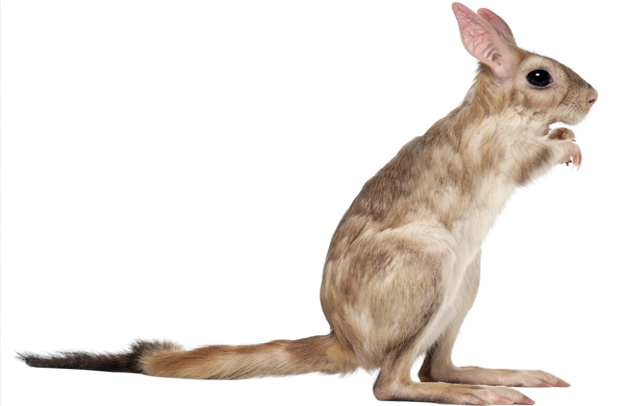Amazing Facts About Springhare

The springhare, also known as springhaas, very much looks like a small kangaroo and like a rabbit with long powerful legs. They are found in southern and eastern Africa. Though earlier listed with the family of jumping rodents, porcupines and some squirrels; springhare was recently allotted a family of its own, the Pedetidae, of which it is the only species. It’s because it differs from other rodents in its anatomy, gait and reproduction. With short round head, large eyes, and some other peculiar features, one of which is long slender legs, it is a natural and enthusiastic jumper and can jump huge heights and distances. What’s more fascinating is that there is more to these creatures than what meets the eyes. Read this article and find out some interesting and amazing facts about the animal that lives on water from dew. Really strange! More of it below…
Facts About Springhare
Binomial Name: Pedetes Capensis
Kingdom: Animalia
Phylum: Chordata
Subphylum: Vertebrata
Class: Mammalia
Order: Rodentia
Suborder: Anomaluromorpha
Family: Pedetidae
Genus: Pedetes
Species: P. capensis
Length: 35 to 45 cm
Weight: 3 to 4 kg
Life Span: 8 years in captivity; even lesser out in the wild
Diet: Mostly herbivorous; roots, fruits, stems, sprouts & herbs, and small insects
Range: South-eastern Africa (Angola, Botswana, Congo, Kenya, Mozambique, Namibia, South Africa, Tanzania, Zambia, and Zimbabwe)
Habitat: Dry and sandy soil, especially at places where the cattle graze or crops are cultivated
Age of Sexual Maturity: One year
Gestation Period: 78 to 82 days
Average Litter Size: 1
Interesting And Fun Facts About Springhare
- The head of a springhare is short and round with a thick muscular neck underneath. It also has very large eyes, and long, narrow upright ears.
- There’s a flap of skin at the base of a springhare’s ear that the creature can close completely to prevent dust from entering in the ear.
- The claws of springhare’s forelimbs are very sharp which they use for digging and making burrows while the hind limbs are long and powerful for jumping.
- It is the only mammal to have a septum in its lower trachea. Other than springhare, this physical characteristic is found only in birds.
- The covering of springhare varies from yellow-brown to brownish-red while the tip of the tail and ears are black.
- The springhare is prey to a wide range of predators like snakes, jackals, weasels, owls, mongooses, and lions.
- Springhare is often called a “mini kangaroo” as a springhare can cover 2-3 metres in a single jump. It is actually neither a kangaroo nor a hare, but in fact, a rodent. Even scientists have found it difficult to classify springhare satisfactorily,
- The springhare has a gestation period of 78-82 days and it generally gives birth to one young at a time. On an average, this newborn weighs around 270 to 300 g. Most female springhares give birth three times a year.
- A newborn springhare has hair coverings its entire body at the time of birth and its eyes open in about 3 days. It leaves its mothers when it is seven weeks of age and weighs around 1.5 kg.
- Springhares reach sexual maturity in about 1 year, when their body weight is 2.5 kg.
- Springhares are nocturnal animals and are only occasionally active during the day.
- Springhares make their burrows near large trees or bush within their home range. They emerge from the burrow during the night to feed. A pair has several burrows with many entrances.
- The home range of springhares is within 25 to 250 metres.
- Sometimes, springhares take a huge leap to exit from their burrow. It is said that they do this to escape their predators, which may be waiting outside the burrow.
- A springhare walks on four legs when eating but when it is frightened it takes long leaps on hind legs and hides in the nearest burrow.
- Springhares are mostly herbivorous; they generally like to eat sprouts, fruits, herbs, barley, oats and wheat but are sometimes found to eat some insects as well.
- They can travel quite fast and are known to travel up to 30 km in search of food and water in times of severe drought.
- The springhares have very good senses; it has an amazing sight, hearing and scent, and can also sense the vibration from the ground through its large feet.
- It is estimated that 2.5 million springhare were killed by indigenous people of Botswana for food. Their skins are also used to make water containers, mats and threads.
- Bushmen, a tribe in Africa is also known to consume springhares as food. They eat most of the springhare, including the eyes, brain, and stomach.
- Apart from various tribes, springhares’ greatest rivals are the domestic animals.
- Generally, springhares are silent animal but do make a grunt like sound when excited. When in danger, they are also known to bleat.
- Springhare’s hind legs and tail helps to balance its body which in turn helps it move faster.
- Springhares do not drink much water; they get sufficient amount of moisture from rain and dew.
- The springhare was declared ‘Vulnerable’ by the International Union for Conservation of Nature (IUCN) in 1996 due to an approximately 20 % decrease in their population. However, in 2004, their status was reclassified under ‘Least Concern’ by the International Union for Conservation of Nature (IUCN).









